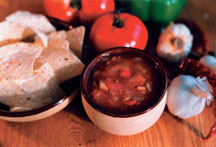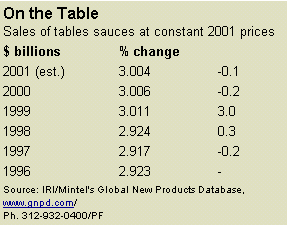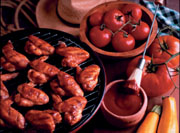With inflation-adjusted growth averaging 3.2% annually over the past five years, table sauce sales are well ahead of the overall food price trend, which is closer to 2.5%. Unit sales of table sauces have grown an average of only 1.5% per year. Thus, the industry has been successful in increasing prices.
H.J. Heinz, Pittsburgh, Campbell Soup Company, Camden, N.J., and Reckitt Benckiser, Berkshire, U.K., are among the leading manufacturers in this potent area of the industry, and they also are among companies who have reorganized to focus on a smaller number of core brands. Mintel believes the increased advertising and promotion of such sauces will be instrumental in their continued sales growth.
“Hot” Sauces
Much of that expansion will be on the back of salsas and other “Mexican sauces,” the largest segment, accounting for nearly one third of the category's growth (in dollars) between 1996 and 2000. An increasing Hispanic population is one key, but so is a widespread interest in new, ethnic tastes and flavors. While ketchup is the most widely used table sauce (found in some 95% of U.S. homes, according to the Mintel report), salsas and hot sauces have posted strong gains in recent years and now are found in 37% and 23% of American homes, respectively.
For its report, Mintel includes taco sauce, salsa and picante sauces among “Mexican sauces,” while “Oriental sauces” include soy sauce, teriyaki and other Asian sauces. The latter enjoyed a “substantial” increase in average price per unit between 1996 and 2000, an increase of roughly 13%. Combined with its 4% jump in unit sales, Oriental sauces totaled a 17% rise in dollar sales for the period under review.

Indeed, the past two decades have seen salsa bring Mexican flavors to a mainstream market, a trend that shows no signs of slowing. Campbell Soup continues strong support of its Pace brand, and Frito-Lay's, Plano, Texas, Tostitos also are pushing the Mexican segment more into the mainstream. Mintel believes that, as Hispanics continue to compose a larger share of the population, “their direct purchases and the purchases they influence will keep annual sales (of Mexican sauces) increasing at a healthy rate.”
Nonetheless, don't expect any sauces to overtake ketchup's healthy volume lead. With a 95% penetration in American kitchens, ketchup has a distinct advantage over other sauces, yet manufacturers continue to find ways to boost consumer interest. Packaging innovations have been one element, as no-drip caps and child-friendly packaging lured consumers. However, Heinz showed there are other ways to gain the attention of shoppers—particularly their children.
The addition of color—currently the ketchup palate stands at three, purple and green, plus the original red—combined with a bottle that is easier for children to hold, produced an item that is one of the most successful recent introductions to the table sauces category.

Two For the Home
Mintel found that about 16 million more bottles of ketchup were sold in 2000, as compared with 1996. This number becomes even more significant when considering ketchup's high household penetration, meaning notable growth was not achieved through the addition of new customers. Therefore, this expansion is the result of the industry's active promotion, improved bottle design and new color variations.Those new colors had one target—children, a prime force in the market for table sauces (ketchup). This market force is substantial because of their direct spending power and the influence they wield over the family shopper. Households with children, Mintel says, are “stronger consumers of every major category of table sauces than households without children. Also, in most segments, the likelihood a household will have a particular table sauce generally increases with the number of people in the household.”
An attraction for the kids, the new ketchup colors led to what may be an unprecedented feat in some American homes—having more than one bottle of ketchup in the pantry or refrigerator (one for the kids and one for the adults). Other sauces are unlikely to approach such acceptance and penetration in the near future but, Mintel says, the true test of ketchup manufacturers will come over the next five years, as generation Y grows out of the traditional ketchup user bracket—children under the age of 12. For ketchup to continue its dominance, it will have to appeal to more sophisticated age groups.
Heinz may have had this in mind when it debuted its flavored ketchup varieties in late 2001. Ketchup Kick'rs are traditional ketchups augmented with garlic, barbecue sauce or Tabasco sauce and, according to Heinz reports, consumers have responded positively to the new line.
This willingness to experiment with new flavors has generated strong sales growth for a spicy, nontraditional sauce—horseradish sauce. According to Mintel, this sauce's success comes in the wake of fairly substantial price increases—of 8-12% for the six leading manufacturers. The rising prices have been prompted by an impending threat to half of the U.S. horseradish crop, and Mintel speculates that manufacturers have staged a pre-emptive price increase in anticipation, an increase that may continue.
Changing Tastes
Another important age group to bear in mind is the Baby Boomer generation, a driving force in accepting new additions to the American dining experience, notably Chinese, Mexican, Cajun, Thai and other offerings. Expect sales to seniors increase, as aging Boomers accept a wider range of tastes.That same group, however, also may respond to another recent trend in the overall food industry—nostalgia. Indeed, Mintel found that expansion in table sauces was not relegated to new offerings. With iceberg lettuce and red meat on dinner tables again, two traditional table sauces have been direct beneficiaries—ketchup and mustard.
That renewed interest in traditional flavors has been a boon to mustard, particularly the yellow variety. While yellow stands as the best-selling variety of mustard, only a few years ago some manufacturers expressed concern that Dijon and other gourmet items would overrun the mustard market. That clearly has not come to pass, as now even Grey Poupon—once the leader of the mustard revolution—has introduced a yellow version, to boost its share of the overall mustard segment.
Mintel believes this return to traditional favorites—in the form of yellow mustard, ketchup and barbecue sauces—indicates consumers' desires to return to familiar flavors.
However, the overall health of the table sauces market may well depend on sauces' ability to be used with quickly-prepared food, for that is the trend in the American home. Presently, only 40% of meals are eaten at home, says Mintel. Mintel believes the future of these sauces as a market is largely dependent on whether younger Americans learn to eat more meals at home, as they mature and form families.
For more information on the report, “The U.S. Vegetarian Foods Market,” contact Mintel International Group Ltd; 213 W. Institute Place, Suite 208; Chicago, IL 60610; phone: 312-932-0400
